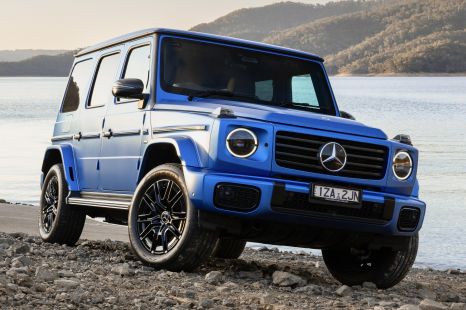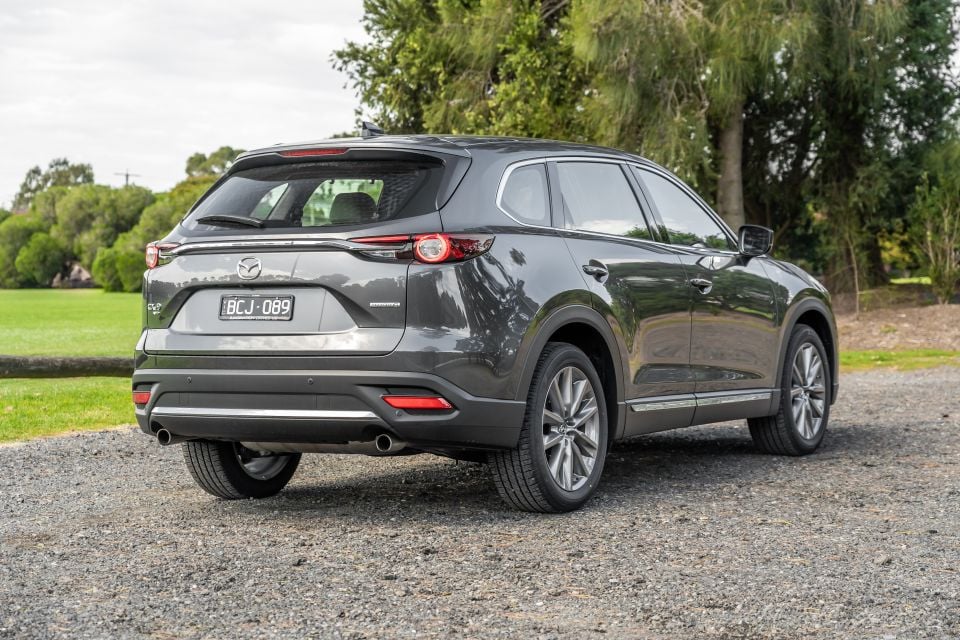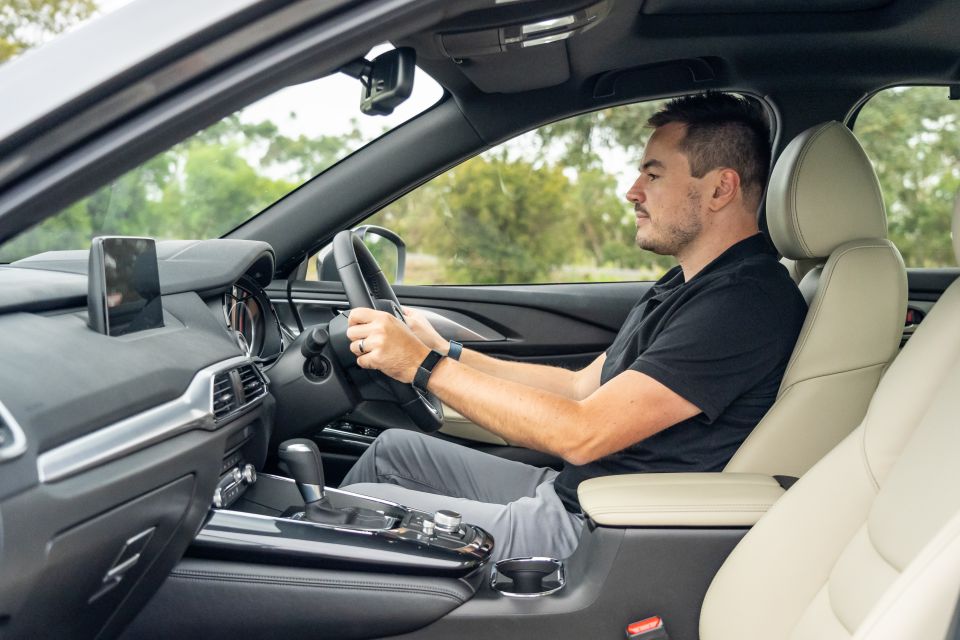

Max Davies
4 Days Ago
A punchy petrol engine, plenty of space, and a lovely upmarket interior. What's not to like?



Founder
New from
$45,920
excl. on-roads

Founder
New from
$45,920
excl. on-roads


Founder
New from
$45,920
excl. on-roads

Founder
New from
$45,920
excl. on-roads
Quickly see how this car stacks up against its competition. Select any benchmark to see more details.
Take advantage of Australia's BIGGEST new car website to find a great deal on a Mazda CX-9.
Growing up, families with stacks of children or kid-hauling duties were bound to people movers like the Toyota Tarago, Honda Odyssey or Kia Carnival. Fast forward to 2020 and the trend has well and truly moved towards SUVs.
That’s where giant SUVs like the Mazda CX-9 have taken off. They provide some of the space you get in a people mover, but avoid the dowdy looks associated with an old-fashioned minivan – because it’s important to look trendy when hauling kids about the place.
Fun fact: the 2020 Mazda CX-9 GT is actually longer than a 200 Series Toyota LandCruiser! The Mazda measures 5075mm long, while the LandCruiser is marginally shorter at 4990mm.
That should give you an idea of how big this seven-seater actually is.
Despite its size, the CX-9 doesn’t actually feel too big on the road. We’ve taken the keys to the CX-9 GT initially for a week to see what it’s like to live with, but will hold on to it for a couple more months to see how it stacks over the long term.
The CX-9 is Mazda’s biggest offering, and sits above the medium-sized CX-5 and the almost-large CX-8.
The CX-9 range starts from $45,920 before on-road costs for the entry-level front-wheel drive seven-seat CX-9 Sport, and tops out with the $69,303 before on-road costs Azami.
This vehicle we’re testing is the all-wheel drive CX-9 GT, which sits one below the Azami and is priced from $65,720 before on-road costs and is available with front-wheel drive for $4000 less.
Mazda’s entire CX-9 range comes with seven seats and the option of front-wheel drive or all-wheel drive.


You can pick from seven colours, with Machine Grey and Soul Red costing an additional $495.
Chief seven-seater SUV competitors include the Kia Sorento GT, and Hyundai Santa Fe Highlander. If you want something more off-road-ready there’s the Ford Everest, while if you want something a little bit luxurious you could stretch to a base Lexus RX from about $73,000.
Regardless of which model you land on, Mazda offers a generous level of standard equipment.
Being one rung from the top of the CX-9 ladder, the CX-9 GT is equipped with a stack of features.
On the outside, you’ll find 20-inch alloy wheels, auto-folding and heated door mirrors, a sunroof, a powered tailgate, halogen daytime running lights, LED headlights with automatic high beam, LED fog lamps, LED tail lights and radar cruise control with stop/go functionality.




Before we get to the inside, it’s worth pointing out parts of our car’s front end were peeling lightly. We’re not sure if it’s just the protective clear coat on the plastic, or whether it’s a defective paint layer.
Inside the cabin there are leather seats, tri-zone climate control, integrated rear window shades, USB charging in all three rows, an auto-dimming rear-view mirror, heated seats in the first and second row, 10-way powered seats for the driver and six-way adjustable ones for the passengers, one touch walk-in for the third row, keyless entry and start, and a reverse-view camera.
ANCAP awarded the Mazda CX-9 with a five star safety rating in 2016, where it scored 35.87 out of 37 points.
It was tested ahead of ANCAP awarding a passenger and vulnerable road user test score, so it’s tricky to directly compare it with some competitors in this segment.
Standard safety equipment includes low and high-speed autonomous emergency braking (AEB), rear cross-traffic alert, front and rear parking sensors, blind-spot monitoring, lane-keeping assist, and a full suite of airbags – including coverage for the third row.
Mazda has kicked serious goals when it comes to interior presentation. The interior looks premium, and feels like a more expensive German car than a family-oriented Japanese vehicle.


In the first row there’s acres of room, and all the critical controls are easy to recognise and access.
The wraparound dashboard layout makes you feel cosy and helps make what is a seriously big car feel a bit smaller. From the driver’s seat it doesn’t feel anywhere near as intimidating as its dimensions might suggest.
At first glance the interior is let down by a relative lack of technology compared to some of its peers. For example, the gauge cluster is fully analogue, where the new Mazda 3 picks up an LCD display ahead of the driver.
The CX-9 also uses an older version of Mazda’s MZD Connect infotainment system and, while it does come with Apple CarPlay and Android Auto, the 9.0-inch screen lacks the polish of the widescreen unit fitted to the new Mazda 3.
The infotainment system is also a little clunky to use. While the screen offers touchscreen functionality while stationary, it doesn’t feel as sharp or usable as other vehicles in this segment.



Navigating through radio stations is a clumsy process, while the voice recognition function makes entering addresses laborious.
Functionality aside, the CX-9 comes with an impressive 12-speaker Bose sound system that uses a 294 Watt amplifier and speakers scattered throughout the cabin. It also comes with AM/FM and DAB+ digital radio.
Leg- and headroom in the first row is excellent, but I found the lack of space between the steering wheel and the top of the centre console lid a little frustrating. My elbow gets caught between the wheel and the console when turning left.
Outside of this, the seats are very comfortable and provide plenty of lateral support. It’s the same story in the second row. There’s a surprising amount of leg- and headroom, even for taller passengers.
We loved the integration of window blinds into the window frame. They’re easy to put into place and retract without much effort.
Second row passengers get access to a fold-down centre arm rest with USB charging ports, along with their own climate control zone and heating for the two outboard seats.
Access to the third row is through a clever one-touch button that drops the seat and slides it forward. It allows easy access to the third row, even for adults. There’s also a clever recess in the lower portion of the C-pillar for kids to grab when climbing in.
While it’s primarily built for kids and small people, the third row can be used by adults with the second row slid forward slightly. There’s also adequate headroom and a comfortable set of seats.



Unlike vehicles like the Ford Everest or Mitsubishi Pajero Sport – SUVs built around a dual-cab ute chassis – there is usable cargo space hidden behind the CX-9’s third row. You’ll find 230L of cargo space behind the third row, which expands to 810L when the third row is folded into the floor.
This is arguably the best part about the Mazda CX-9 – its engine.
The entire range is powered by a hearty 2.5-litre turbocharged four-cylinder petrol engine producing 170kW of power and 420Nm of torque, mated to a six-speed automatic torque converter transmission.
It’s linked to an on-demand all-wheel drive system and consumes a combined 9.0L/100km of fuel. In practice you can actually achieve very close to that figure.



Reaching its peak torque figure at 2000rpm, there’s rarely ever a need to get stuck into the throttle – also partly helped by its comparatively meagre 1885kg tare mass. It’ll also run on 91RON fuel, which is great news.
If you ever need to tow, it’s also capable of hauling up to 2000kg with a braked trailer.
We love the engine, so you can see where we’re headed with this. The engine helps gel the chassis with the driver, and is a window a driving experience that’s (dare we say it) fun at times.
The engine offers plenty of squirt from low speeds and is eager to rev through the 5000rpm peak power band for overtaking, or under other short, sharp stabs of the throttle.
Despite its size, the Mazda CX-9 is fairly easy to park and the steering is light enough – without lacking in feel – at low speeds to make the task even easier. Dial up the speed and the steering offers plenty of feedback without the rack rattle that afflicted the old CX-9.
Brake pedal feel is good, but we’re really not a fan of Mazda’s i-stop start/stop system. It’s quite intrusive and jars the car when it activates. Unlike many other cars in this segment that offer an idle stop system that activates while the car is rolling to a stop, you need to wait until the car is stationary and the brake pedal is pressed hard.


There’s a layer of road noise communicated through to the cabin through the 255mm wide tyres and 20-inch alloy wheels. It’s not excessive, but you notice it when you hit a coarse chip section of road.
Outside of the road noise, the ride is fantastic and the Mazda CX-9 does an excellent job of handling the bumps and undulations you’ll find on urban streets, plus corrugated sections of gravel roads prevalent in rural Australia.
Visibility out the front, sides and rear is excellent, helped by big wing mirrors. They hold a blind-spot monitoring system that helps spot traffic around you.
There’s a lot to like about the Mazda CX-9. What makes it most pleasing you get access to that punchy four-cylinder engine that generally remains turbo lag free, but doesn’t guzzle fuel. It feels more usable than the V6 offered in the Toyota Kluger, but won’t chew through the same amount of petrol.
Mazda offers a five-year, unlimited-kilometre warranty for its entire range. CX-9 service intervals are every 12 months or 10,000km – whichever comes first.




Over a five year period, the CX-9 will cost $1905 to service, which comes out at an average of $381 per service.
Keep in mind most Australians travel more than 10,000km per year, so it’s likely you will need to perform an additional one or two services over a five year period.
I get it. The last car you want to be seen in is a people mover. What’s the next best thing?
I reckon it’s this. The Mazda CX-9 ticks a lot of boxes when it comes to space, comfort, and features. The engine is fantastic and it loves eating up miles on the open road.




If I could pick some things that you’d want changed – that infotainment system is feeling old school now.
If it was my money, I’d hold out for an update to the CX-9. It can’t be too far away from picking up the widescreen navigation system fitted to the Mazda 3. Equally, if you’re not fussed by that, Mazda will start doing runout deals on the current model as soon as the new one is announced.
Either way, it’s a great family bus. A decent warranty and reasonable running costs give you a decent looking SUV that doubles as a school bus. It’s hard to go wrong.
Take advantage of Australia's BIGGEST new car website to find a great deal on a Mazda CX-9.
Paul Maric is an Australian car expert based in Melbourne, Australia. Paul is a founder of CarExpert.com.au & formerly part of the CarAdvice founding team.


Max Davies
4 Days Ago


Max Davies
4 Days Ago


Josh Nevett
3 Days Ago


William Stopford
3 Days Ago


Matt Campbell
2 Days Ago


Marton Pettendy
2 Days Ago